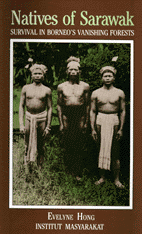|
 Natives
of Sarawak: Survival in Borneo's Vanishing Forests Natives
of Sarawak: Survival in Borneo's Vanishing Forests
Evelyne Hong
Institut Masyarakat
ISBN: 967-9966-03-8
266 pages
15x24.5cm
Third World: Hardcover: US$13.00
Others: Hardcover US$20.00
This
book is an in-depth analysis of the problems faced by the native peoples
of Sarawak, most of whom live in long-house communities in Borneo's tropical
forests.
It describes
the traditional social and economic system of swidden agriculture, and
how their forest resources and way of life are increasingly threatened
by the forces of 'modernisation'.
Focus
is given on how the natives' customary lands are being encroached upon
by the timber industry and development projects such as the construction
of large dams. Included are oral testimonies from several native communities
about their plight.
The
book also analyses the social and environmental impact of logging activities,
and provides suggestions of what can be done to resolve the natives's
problems.
The
book is essential reading for those interested in Sarawak, and its natives,
the fate of the tropical forests and the rights of indigenous peoples
in the Third World.
CONTENTS
Sarawak
and Its People
- Traditional
Dayak Swidden Society
-
-
Longhouse social organisation
Customary land tenure
Shifting agriculture and other economic activities
- Swidden as a
Rational Agricultural System
-
-
Shifting agriculture: complex and ecologically sound
Multiple cropping
Self sufficiency in rice
Economic use of land
Conservation of soils: retention of nutrients
Conservation of soils: minimal soil erosion
The forest as an important source of animal and plant resources
The increasing marginalisation of shifting cultivators
- Changes in Sarawak's
Land Laws: Impact on Natives
-
-
The significance of land to the natives
The encroachment of the modern state on native land
The 1863 land Order
The 1875 Land Order
Fruit Trees Order I, 1899
Land Order No. VIII and No. IX, 1920
The Land Order (Order L-2), 1931; and Land Settlement Order, 1933
Secretariat Circular No. 12/1939, Native Customary Tenure
The 1948 Land Classification Ordinance
The 1958 Land Code
Mixed Zone Land
Native Area Land
Native Customary Land
Interior Area Land
Reserved Land
The 1962 Land Committee
Extinguishment of Native Customary Rights
The 1979 Land Code (Amendment) Ordinance
Land Development Schemes
- Impact of Land
Development Schemes
-
-
Factors causing loss of Native Land
Land development policy
The Sarawak Land Development Board
The Sarawak Land Consolidation and Rehabilitation Authority
The Land Custody and Development Authority
The integrated agricultural development projects
The Natives' response to land development
- Forest Policy
and the Natives
-
-
Forest policy and the Forests Ordinance 1953
1979 Amendments to the Forests Ordinance
Consequences of land and forest lawas on the natives
- Natives versus
Timber, Fight for the Forest
-
-
The clash between traditional and commercial systems
Encroachment of logging into native lands
Cases of native communities affected by logging activities
Native resistance in the Fourth Division
Ulu Belaga: the 1983 timber dispute
Ulu Belaga: unsuccessful requests for communal forests
Ecological damage by logging: impact on native communities
- Logging and
Forest Depletion in Sarawak
-
-
Who is to blame for forest destruction?
Forest depletion in Malaysia
Rapid forest depletion in Sarawak
Forest concessions in Sarawak
-
Extent of new forest opened up by swiddeners
Use of forest resources by swiddeners
Pro-timber, anti-swidden prejudices
- Social and Impact
of the Timber Industry
-
-
Sarawak's timber industry
Forest exploitation: who benefits?
Low skills and high safety risks for timber workers
Forest exploitation: the environmental impact
Logging: a wasteful industry
- Dams Flooding
Out Native Lands
-
-
Plans to build dams in Sarawak
The Batang Ai hydro power project
The Bakun hydro power project
Problems of resettlement caused by dams: the international experience
The environmental impact of dams
- Consequences
of Modernisation and Development on the Natives
-
-
Land scarcity
Reduced food output and malnutrition
Migration to the towns
Cultural alienation and the passing away of traditional swidden society
Conclusion
- The Cultural
and Development Rights of Natives
-
-
International conventions protecting cultural minoritie
The case of Sarawak natives
The right to development
The right to cultural identity
- Towrds the Restoration
of Native Rights
-
-
Royal Commission of Enquiry
A new forest policy
A new land policy
A new agricultural policy
A Hydro electric dam projects
Health, food and nutrition policy for natives
Other services
Native autonomy
Conclusion
Bibliography
-
One: Shifting cultivation - comparative data on labour expenditure
and yield among shifting cultivators in Southeast Asia
Two: Principal forest types and other land use, 1970
Three: Production of logs and hewn timber 1984
Four: Letter to the Prime Minister from Baram natives
Five: Native account of native-timber company conflict, Baram
Six: Letter to Member of Parliament from Baram natives
-
1. Land area according to land tenure categories, 1985
2. Forest and other land as at 31.12.84
3. Classes of forests, 1968-84
4. Production of logs in Malaysia
5 . Estimates of forest area logged 1963-85
6. Forest area under logging licence in working and felling plans
as at 31.12.84
7 . Forest area under logging licence (Management Plan Areas) as percentage
of total forest area, 1984
8. Export of saw logs and sawn tmber 1976-85
9A. Protein-calorie malnutrition among 4,106 Sarawak children under
nine years old by percentage WHO standard weight for age
9B. Child malnutrition rates in developing areas by Gome weight categories
10 . Incidence of malnutrition-by-weight in Sarawak Divisions, 1980
11. Incidence of malnutrition-by-weight in Sarawak: age groups
-
BACK TO
MAIN | ONLINE BOOKSTORE
| HOW TO ORDER

|
 Natives
of Sarawak: Survival in Borneo's Vanishing Forests
Natives
of Sarawak: Survival in Borneo's Vanishing Forests